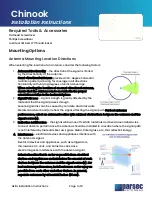
Nera SatLink Terminal User Guide – Revision P
110
Appendix K.
TCP enhancement and tuning
K.1
General introduction to Performance Enhancing techniques
The Transmission Control Protocol – TCP now is used by most applications on the Internet (e.g. HTTP,
POP3 and FTP). The protocol is designed for controlling the end-to-end flow of data over an IP network,
by imposing error control and congestion control. When using the protocol in satellite networks, the
mechanisms designed for improving the throughput in terrestrial networks, is acting counterproductive
due to the RTT delay. The problem areas of TCP are mainly:
•
Window size algorithm: the amount of data a sender will transmit is limited by a sliding window
protocol. The window is controlled by the reception of acknowledgement packets. This regulation
loop is very slow in satellite networks, and results in poor performance.
•
Slow start/ Congestion avoidance algorithm: When the protocol entity detects congestion (or rather
detect a situation perceived as congestion), the sending buffer is reduced in what is called the slow
start/congestion avoidance algorithm. Packet loss is interpreted as congestion by the TCP entity. This
means a high impact on bandwidth of a simple packet error.
•
Backchannel bandwidth: TCP needs a certain bandwidth for the back-channel in order to transmit
acknowledgements. The back channel will limit the forward channel. This is a limitation for
asymmetric channels like satellite access links.
To counter act some of these shortcomings, several actions can be taken using the standard TCP (and IP)
features and parameters. RFC 2488 recommends the following actions:
•
Path-MTU Discovery: is a feature of the underlying IP network. The purpose is to determine the
maximum packet size a connection can use on a given network path without being subjected to IP
fragmentation. Fragmentation requires more CPU overhead in the intermediate routers, and will
increase the delay. The mechanism utilises the IP header “don’t fragment” bit, and transmits packets
with decreasing size (from the maximum allowed on the local network) until the packets are received
correctly by the destination. In the satellite network it is important to tune the packet size to the MPEG
frames used on the link.
•
FEC – Forward Error Correction: is utilised.
•
TCP congestion control: The Slow start and congestion avoidance algorithms described above are
limiting satellite operation. However they are required by the standards, and can not be avoided. The
Fast Retransmit and Recovery mechanisms are somewhat reducing the effect of the slow
start/congestion avoidance, and are both part of all current TCP/IP implementations.
•
TCP Large windows: a path with a high bandwidth x delay product like the satellite link, needs a long
transmission window in order to utilise the bandwidth. The throughput of TCP is limited by the
formula: throughput = window size / RTT
•
Standard window size for TCP is 65 535 Bytes which means that the maximum throughput on a
satellite link is: 65535 B /560 ms = 936.2 kbit/s. This is below the forward link capacity. By increasing
the window size higher performance can be achieved. For web browsing this is normally not a
limitation, as more TCP connections are operating at the same time (normally 4 for HTTP 1.0). For
newer HTTP 1.1 browsers, this may become a limitation, as several HTTP request/reply sessions can
be multiplexed onto the same TCP connection (require support from server).
•
Window scaling: To enable window sizes above 64KB, the window scaling option according to RFC
1323 should be implemented to avoid sequence number overlap (as 16 bits can only represent 65535 at
the maximum). And the accompanying protocols
•
RTM – round trip measurement: more refined round trip measurement by means of timestamps.
•
PAWS – Combination of timestamps and sequence numbers to detect wrapped sequence
numbers.
Содержание SatLink 1000
Страница 1: ...Nera Broadband Satellite AS...
Страница 2: ......
Страница 3: ...Nera SatLink Terminal User Guide Revision P 1 Nera SatLink Terminal User Guide...
Страница 63: ...Nera SatLink Terminal User Guide Revision P 61 Figure 17 Statistics page...
Страница 66: ...Nera SatLink Terminal User Guide Revision P 64 Figure 19 Information concerning the current DHCP configuration...
Страница 74: ...Nera SatLink Terminal User Guide Revision P 72 Figure 24 Terminal line up web page...
Страница 84: ...Nera SatLink Terminal User Guide Revision P 82 Insert the remaining screws and tighten firmly with an Allen key...
Страница 100: ...Nera SatLink Terminal User Guide Revision P 98...
Страница 114: ...Nera SatLink Terminal User Guide Revision P 112 Figure 30 Dr TCP utility...






































